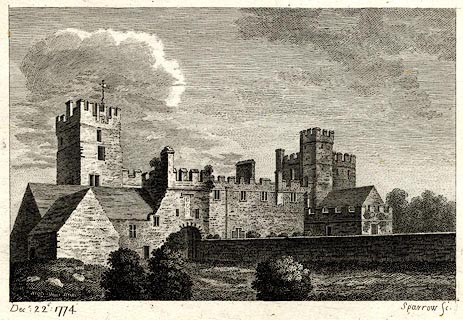

Dove Cottage : 2008.107.489
image:-
© see bottom of page

click to enlarge
Included in The Antiquities of England and Wales, by Francis Grose.
There is descriptive text on the rest of the page and the reverse:-
NAWORTH CASTLE, CUMBERLAND.
PLATE II.
TRADITION says this castle was built by the Dacres, but by which of them is not ascertained. One of them, Robert de Dacre, from a quotation in Madox's History of the Exchequer, seems to have been sheriff of Cumberland, 39th of Hen. 3d, and another, Ranulph de Dacre, 14th of Ed. 1st, constable of the tower.
THE first mention of this castle is in the reign of Richard 2d, when in the 18th of that reign, it appears from Madox's Beronia, that William de Dacre, son and heir of Hugh de Dacre, who was brother and heir of Ranulph de Dacre, held it, with the manor of Irchington, to which it belonged; also the manors of Burgh, near Sandes, Laysingby, and Farlham, and other lands, by the service of one entire barony, and of doing homage and fealty to the king, and of yielding to him for cornage at his exchequer at Carlisle yearly, at the feast of the assumption of St. Mary, 51s. 8d. By what feofment, whether old or new, says Madox, does not appear; neither in what king's reign Ranulph de Dacre, ancestor of William here named, was feoff'd; but it is plain, some ancestor under whom Ranulph claimed, was enfeft to hold by barony.
IT continued in the family of the Dacres, till the year 1569, when on the 17th of May, according to Stowe, "George Lord Dacre of Graystoke, sonne and heire of Thomas Lord Dacre, being a child in yeere's, and then ward to Thomas Lord Howard, Duke of Norfolk, was by a great mischaunce slayne at Thetford, in the house of Sir Richard Falmenstone, knight, by meane of a vauting horse of wood, standing within the same house; upon which horse, as he meant to have vauted, and the pinnes at the feet being not made sure, the horse fell upon him, and bruised the brains out of his head."
IN the January following, Leonard Dacre, Esq; of Horsley, in the county of York, second son to Lord William Dacre of Gilsland, being dissatisfied with a legal decision, by which his nieces were adjudged to succeed to the estate of their brother the Lord Dacre, whose tragical death was just here related; he entered into a rebellion, with design to carry off the Queen of Scots; but being disappointed by her removal to Coventry, and having the command of 3000 men, which he had been entrusted to raise for the queen's service, he seized several castles, among which were those of Greystock and Naworth; but being attacked and defeated by Lord Hunsdon, at the head of the garrison of Berwick, he fled to Falnders, where he died.
THIS castle next came into the possession of Lord William Howard, the third son of Thomas Duke of Norfolk, in right of his wife Elizabeth, sister of George, the last Lord Dacre, beforementioned. In 1607, when Cambden visited it, it was under repair; and Bishop Gibson says, it was again repaired and made fit for the reception of a family, by the Right Hon. Charles Howard, great grandson to the Lord William Howard beforementioned.
I SHALL here transcribe another description of this castle and furniture, sent me by a gentleman who visited it anno 1732, which though it repeats many things mentioned in the former account, yet it has also diverse circumstances worthy observation, not there taken notice of.
"THIS is an ancient stone building; the front long, with a square tower at each angle; then you enter a court. In the noble hall, the pictures of Anglo-Saxon kings, and painted on wooden square panels, make the ceiling, and part of the wainscot at the further end of the room: they were brought from Kirk-Oswald castle when that was demolished. The chapel has a ceiling, and part of its wainscot of the same kind, being paintiings of patriarchs, Jewish kings, &c. Here is also painted a genealogy of the family from Fulcho, with their arms. It has a floor of plaister of Paris, as have some other of the rooms. Some of the apartments are very large and spacious; the ceiling of one consists of small square panels of wood, black and white interchangeably; the white has two different carvings, the black is unwrought. The very little Popish chapel is above stairs; the inside work curiously carved and gilt; here are some small figures of the passion, &c. Joining to this chapel is the library, which has a good wooden roof; the books are old; there are not above one or two of the manuscripts here now. Vide Cat. Librorum M.S. Angl. & Hib. Tom 2d, p.14 &c.. The Earl of Carlisle never lives here, but at Castle-Howard in Yorkshire. In the garden wall are stones with Roman inscriptions, collected probably from the Picts Wall; a general account of these stones is given in Horsley's Britannia Romana."
CAMBDEN, who also mentions these stones, gives the following copy of some of their inscriptions. One is,
IUL. AUG. DUO. . SILV. . UM
On another,
.I. O. M. ... II .AEL. DAC... C.P ... EST / URELIUS. FA. L. S. TRIB. PET. VO. COS.
On a third,
LEG. II. AUG.
On a fourth,
COH. J. AEL. DAC. CORD. ... ALEC. PER. ...
THESE stones were, by the late Earl of Carlisle, given to Sir Thomas Robinson, who married his siter, and were by him removed to his Museum at Rooksby.
This view, which represents the entrance into the castle, was drawn anno 1772.
Decr. 22d. 1774 / Sparrow sc.
 Naworth Castle, Cumberland
Naworth Castle, Cumberland